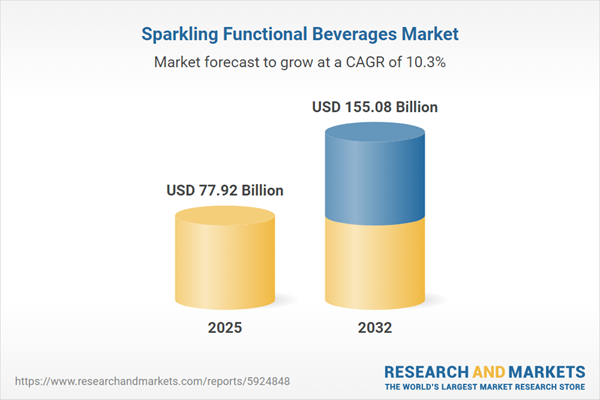Speak directly to the analyst to clarify any post sales queries you may have.
The sparkling functional beverages market is evolving rapidly as health, flavor, and convenience drive professionals and consumers alike toward purpose-driven refreshment choices. This research report delivers actionable insights for leaders seeking to navigate changing trends, consumer demands, and competitive strategies in this dynamic sector.
Market Snapshot: Sparkling Functional Beverages Market Growth Trends
The Sparkling Functional Beverages Market expanded from USD 70.60 billion in 2024 to USD 77.92 billion in 2025. Projected to continue at a CAGR of 10.33%, the market is anticipated to reach USD 155.08 billion by 2032. This momentum reflects an industry propelled by the convergence of wellness priorities, ingredient innovation, and evolving retail and regulatory landscapes worldwide.
Scope & Segmentation: Comprehensive Market Coverage
- Product Types: Functional Soda (energy, vitamin fortified), Kombucha (raw unfiltered), Sparkling Juice Drinks (mixed fruit blend, single fruit blend), Sparkling Water (botanical infusions, fruit extracts, natural flavor).
- Functional Claims: Digestive health, energy, hydration, immune support, mental focus.
- Ingredients: Botanicals (ginseng, green tea extract), electrolytes, probiotics (Bifidobacterium, Lactobacillus), vitamins (B vitamins, vitamin C).
- Distribution Channels: Convenience stores, online retail, specialty stores, supermarkets and hypermarkets.
- Packaging Formats: Bottles, cans.
- Flavor Profiles: Berry (blueberry, strawberry), citrus (lemon, lime), tropical (mango, pineapple).
- Consumer Demographics: Adults, athletes, millennials.
- Regions Covered: Americas (North America, Latin America), Europe, Middle East, Africa, Asia-Pacific (including key countries like the United States, Canada, Brazil, Germany, China, Japan, Australia, among others).
- Industry Players: The Coca-Cola Company, PepsiCo, Nestlé S.A., Danone S.A., Keurig Dr Pepper Inc., National Beverage Corporation, Monster Beverage Corporation, Red Bull GmbH, Hint, Inc., Spindrift Beverage Co., L.L.C.
Sparkling Functional Beverages: Key Takeaways for Senior Decision-Makers
- Consumer demand is shifting toward multifunctional beverages that prioritize health outcomes alongside sensory experiences, creating new product development opportunities.
- Transparency in ingredient sourcing and efficacy claims remains critical for market differentiation and trust-building, especially among health-conscious demographics.
- Technological advances in extraction, fermentation, and encapsulation are key enablers, helping brands to deliver clean-label products without compromising taste or format flexibility.
- Retail channels are diversifying with a significant uptick in online direct-to-consumer models, empowering brands to reach specific target groups with greater agility and personalized offerings.
- Sustainability imperatives are shaping both packaging design and ingredient sourcing, with stakeholders increasingly turning to eco-friendly and regenerative practices to meet evolving regulatory and brand expectations.
- Strategic collaboration—across supply chain partners, ingredient innovators, and retail alliances—remains essential for scale, resilience, and speed to market in this competitive landscape.
Short-Term Tariff Impact: Supply Chain Strategies and Cost Dynamics
Recent tariff adjustments in the U.S. are compelling brands to revisit sourcing, focusing on domestic suppliers and local cultivators to offset increased costs on imported inputs. Logistics models are adapting to blend different transportation modes, supporting continuity and flexibility as trade policy evolves. Ingredient diversification and agile quality management are reinforcing overall market resilience amid regulatory changes.
Methodology & Data Sources
This report utilizes a mixed-method approach, combining detailed secondary research from industry publications, patents, and regulatory filings with primary interviews and surveys involving executives, R&D specialists, and supply chain stakeholders. Quantitative validation leverages syndicated retail data, and expert panel reviews ensure insight reliability and contextual accuracy.
Why This Report Matters to the Sparkling Functional Beverages Industry
- Equips stakeholders with granular segmentation analysis to inform product innovation and targeted go-to-market strategies.
- Provides a detailed view of competitive approaches—including supply chain pivots and new product roadmaps—directly relevant to market expansion goals.
- Presents robust regional insights and regulatory understanding needed for effective cross-border planning and compliance.
Conclusion: Strategic Roadmap for Market Leadership
Success in the sparkling functional beverages sector hinges on agile innovation, operational efficiency, and alignment with evolving health and sustainability preferences. This report provides the intelligence necessary to strengthen positioning and capitalize on emerging growth prospects in a rapidly changing market.
Additional Product Information:
- Purchase of this report includes 1 year online access with quarterly updates.
- This report can be updated on request. Please contact our Customer Experience team using the Ask a Question widget on our website.
Table of Contents
3. Executive Summary
4. Market Overview
7. Cumulative Impact of Artificial Intelligence 2025
Companies Mentioned
The companies profiled in this Sparkling Functional Beverages market report include:- The Coca-Cola Company
- PepsiCo, Inc.
- Nestlé S.A.
- Danone S.A.
- Keurig Dr Pepper Inc.
- National Beverage Corporation
- Monster Beverage Corporation
- Red Bull GmbH
- Hint, Inc.
- Spindrift Beverage Co., L.L.C.
Table Information
| Report Attribute | Details |
|---|---|
| No. of Pages | 196 |
| Published | October 2025 |
| Forecast Period | 2025 - 2032 |
| Estimated Market Value ( USD | $ 77.92 Billion |
| Forecasted Market Value ( USD | $ 155.08 Billion |
| Compound Annual Growth Rate | 10.3% |
| Regions Covered | Global |
| No. of Companies Mentioned | 11 |









